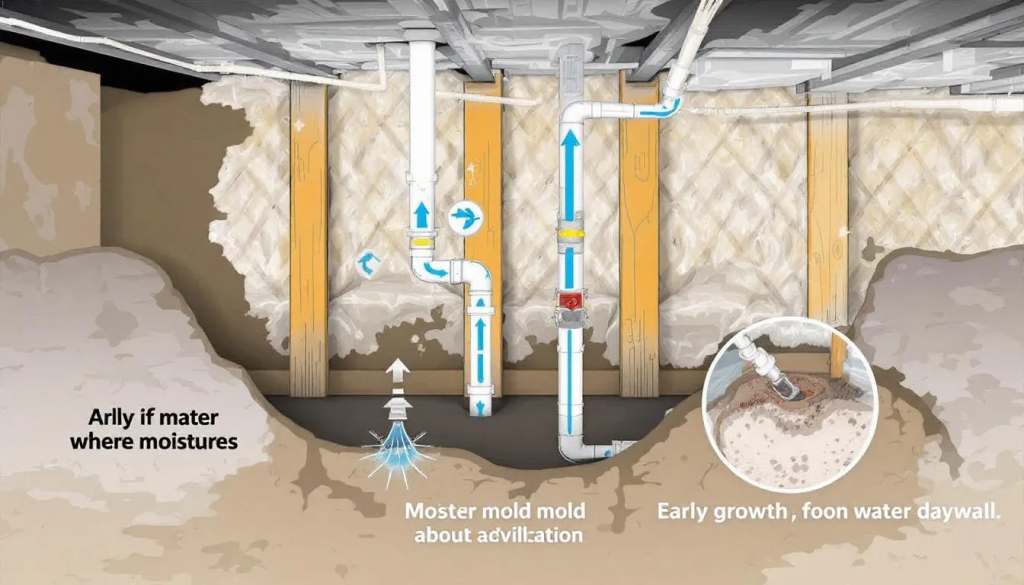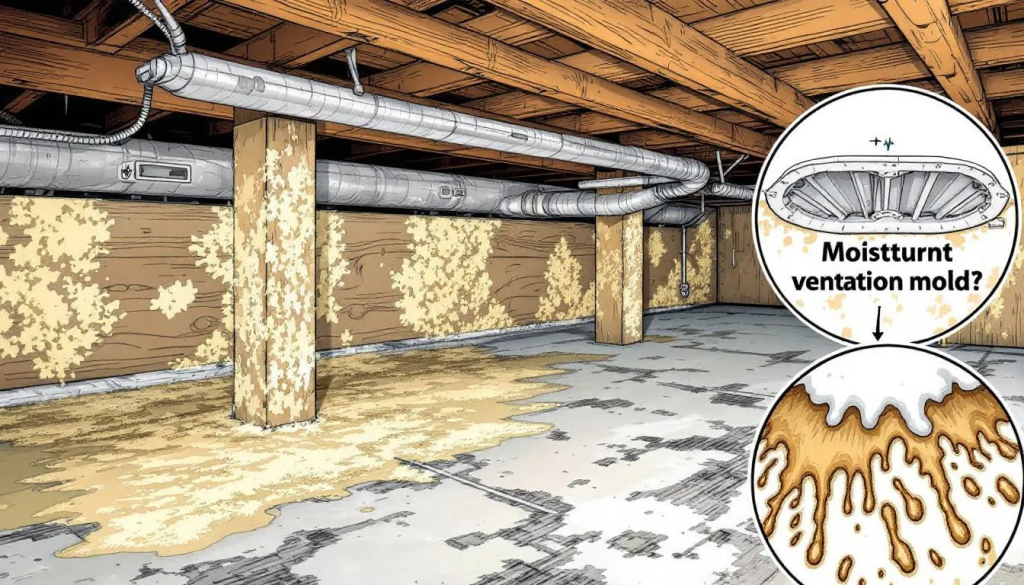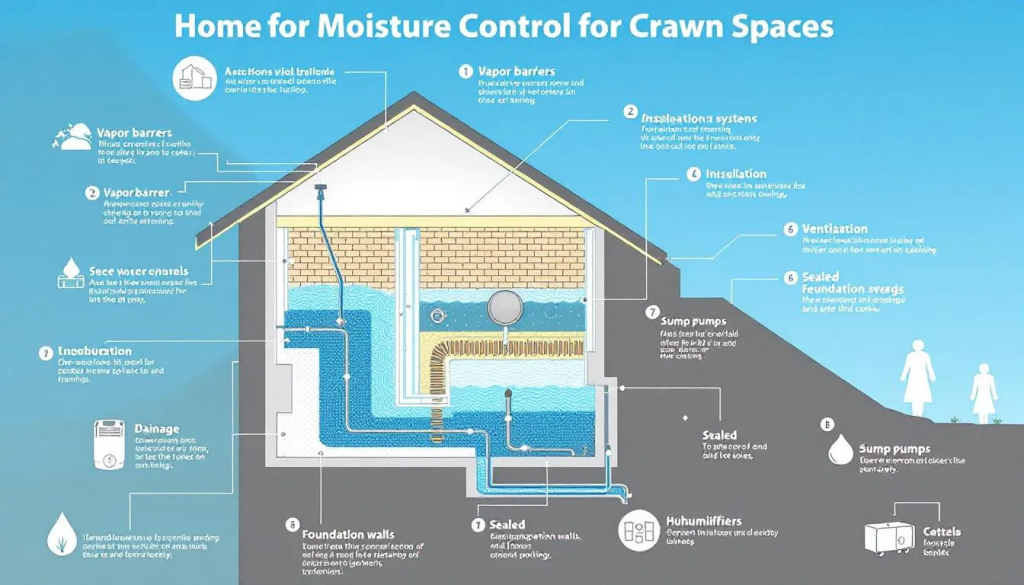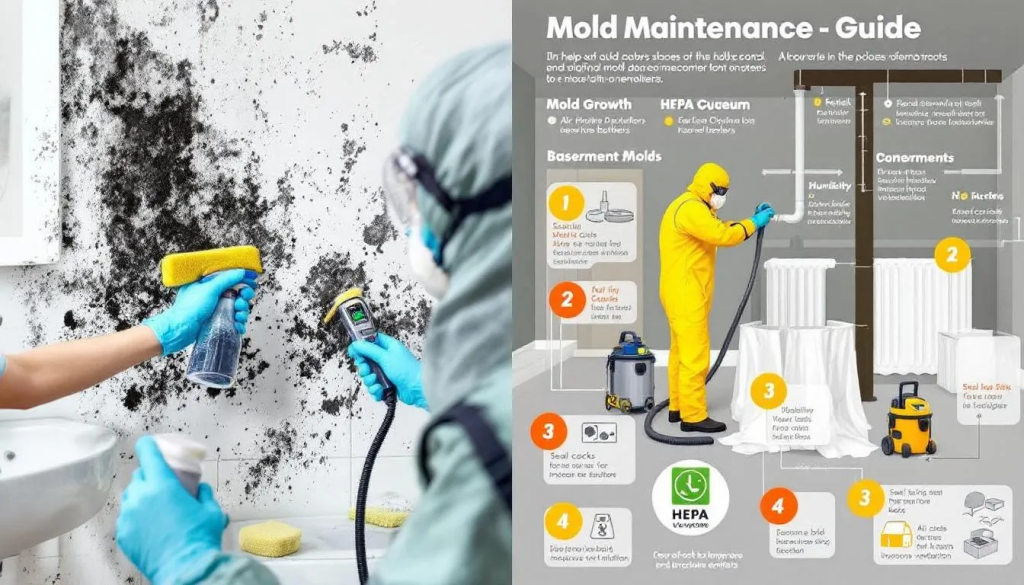Do moldy smells indoors have you concerned about your crawl space plumbing? Moisture from plumbing issues in the crawl space is a major contributor to mold growth and the resulting odors. The air inside the crawl space can directly affect the air quality throughout your home, impacting the health and comfort of everyone inside. This article will explain the link between crawl space plumbing and moldy smells indoors, helping you identify and fix the problem.
Table of Contents
ToggleKey Takeaways
Crawl space plumbing issues, including leaks and standing water, create ideal conditions for mold growth and musty odors.
Regular inspections and moisture control strategies, such as encapsulation and dehumidification, are essential for preventing mold in crawl spaces.
Addressing mold problems promptly is crucial for health, as mold exposure can lead to respiratory issues and long-term health complications.
How Crawl Space Plumbing Issues Lead to Mold Growth

Crawl spaces provide an ideal environment for mold growth due to their dark and damp conditions. Plumbing issues play a significant role in creating these conditions, including:
Leaks and water intrusion
Moisture from plumbing leaks
Condensation
Standing water
Humid air and outside air entering through vents or openings can also increase moisture levels in the crawl space, contributing to mold growth and a damp environment.
These factors can quickly turn your crawl space into a breeding ground for mold.
Mold thrives in these moist environments, feeding on organic material and spreading mold spores throughout the space and beyond, allowing mold grow to occur rapidly, especially when contaminated materials are present. This can lead to a significant mold problem if not addressed promptly.
Plumbing Leaks and Water Intrusion
Plumbing leaks are a common source of moisture in crawl spaces. Leaky supply pipes, slow-draining wastewater lines, and rainwater seeping through cracks can all contribute to persistent moisture. Use a flashlight to identify leaks and listen for unusual noises.
Prompt repair of detected leaks prevents mold growth. Unaddressed leaks can lead to significant mold problems, potentially requiring professional remediation.
Condensation on Cold Surfaces
Condensation occurs when warm air from your home comes into contact with the cold surfaces of floor joists and subflooring beneath the first floor in the crawl space. This condensation creates damp environments that are perfect for mold growth. High humidity levels exacerbate this issue, especially during cold winters when condensation is more likely to form.
Ventilation and heavy duty vapor barrier can mitigate condensation and prevent mold growth. A plastic vapor barrier can also help in this process.
Standing Water and Poor Drainage
Standing water in crawl spaces often results from poor drainage, ground seepage, and hidden plumbing leaks. Water can enter through foundation cracks, vents, or poorly sealed doors, leading to persistent moisture problems.
To keep the crawl space dry and prevent mold growth:
Promptly remove standing water with a wet-vac or pump.
Install and maintain a sump pump to automatically remove collected water from the crawl space.
Address the water source.
Enhance drainage systems.
Clear gutters.
Direct downspouts away from the foundation.
Identifying Moldy Smells Originating from Crawl Spaces

Early detection of musty smells can prevent more significant problems. A musty smell is often a telltale sign of ongoing mold growth, caused by the release of microbial volatile organic compounds.
Odors originating in the crawl space can easily migrate into the living space, affecting the comfort and health of residents.
Addressing the sources of these smells promptly is crucial for maintaining a healthy home environment.
Musty Odors and Their Sources
Musty odors are often a clear indicator of mold in your crawl space. These odors typically arise from moisture sources such as groundwater, soil moisture, leaks, and dirt floors. Mold feeds on organic materials like wood and fabrics, which contribute to these unpleasant smells.
Recent water damage or increased pest activity can also signal the presence of mold.
Visual Inspection Clues
Visual inspections are critical for identifying early signs of mold. During these inspections, look for:
Discoloration on surfaces, which may appear fuzzy and indicate mold presence
Plumbing leaks
Water supply lines
HVAC condensation lines
Structural components such as joists and foundation piers for signs of mold or moisture damage
Early detection can significantly impact indoor air quality and prevent more severe issues.
Unpleasant Odor Pathways
Moldy odors can easily spread throughout your home via HVAC systems. These odors travel through open vents and HVAC ducts, leading to poor ventilation, poor indoor air quality, and air leaks. Sealing other air leaks, in addition to vents and ducts, is important to prevent the spread of moldy odors.
Ventilation and addressing moisture sources can help mitigate the spread of these odors.
Health Risks Associated with Moldy Smells from Crawl Spaces

Mold in crawl spaces can pose various health risks, from respiratory issues to skin irritation. Inhaling mold spores can lead to significant health problems and poor indoor air quality. According to the Environmental Protection Agency, maintaining good indoor air quality is crucial to protect your family’s health from mold-related risks. High humidity and water intrusion in crawl spaces exacerbate these issues, making it essential to address mold problems promptly.
Respiratory Issues and Allergies
Mold exposure can lead to a range of respiratory issues and can trigger allergic reactions. Breathing in mold spores can make family members sick, especially those with existing respiratory conditions or immune disorders.
Ventilation and mold removal improve indoor air quality and protect your family’s health.
Impact on Existing Respiratory Conditions
For individuals with asthma, mold exposure can exacerbate symptoms and lead to more severe respiratory issues. Poor indoor air quality due to mold can significantly impact those with existing respiratory conditions, making it essential to address mold problems promptly.
Long-term Health Concerns
Prolonged exposure to mold can lead to chronic respiratory diseases and long-term health complications. Promptly addressing mold issues prevents adverse health effects and maintains good indoor air quality.
Preventing Mold Growth Due to Crawl Space Plumbing Issues

Preventing mold growth in crawl spaces requires effective moisture management strategies. Regular inspections, moisture control, and proper ventilation are key to keeping your crawl space mold-free. Additionally, crawl space mold prevention is essential for maintaining a healthy environment.
Insulating crawl space walls with materials like rigid foam boards or spray foam helps prevent moisture buildup, condensation, and mold growth, while also protecting the home’s foundation from water damage.
Keeping humidity levels below 55% and addressing any moisture sources can significantly reduce the risk of mold growth.
Regular Plumbing Inspections
Regular plumbing inspections prevent mold growth in crawl spaces. Homeowners should:
Routinely check for leaks and water damage.
Detect plumbing issues early to prevent mold problems.
Reduce the need for professional remediation through early detection.
Moisture Control Strategies
Moisture control strategies include using dehumidifiers in hot, humid climates. Installing vapor barriers and using moisture meters can help detect and manage hidden moisture.
Keeping humidity levels below 50% prevents mold growth in crawl spaces.
Proper Ventilation Techniques
Ventilation reduces moisture accumulation in crawl spaces. Techniques such as air sealing and using HVAC systems can improve indoor air quality and prevent mold growth.
Good air circulation keeps the crawl space dry and mold-free.
DIY vs. Professional Solutions for Moldy Crawl Spaces

When dealing with mold in crawl spaces, homeowners can choose between DIY and professional solutions. DIY removal can be a cost-effective option for small mold infestations, but removing mold thoroughly is essential to prevent recurrence. Small areas of mold can often be addressed with household cleaning products, but larger infestations may require professional mold remediation. The cost of professional mold removal can range significantly, but addressing the issue promptly is essential to prevent further health risks.
Safety Precautions for DIY Mold Removal
When tackling mold removal yourself, wear protective gear like gloves, goggles, and a face mask. Ventilation minimizes inhalation of mold spores during removal.
Following these precautions can help ensure a safe and effective DIY mold removal.
When to Call a Professional
If mold covers more than 10 square feet, it’s advisable to seek professional help. Professional mold remediation ensures proper removal and reduces the risk of health problems associated with mold exposure.
Professional inspection can identify underlying issues contributing to mold growth.
Long-term Solutions: Encapsulation and Insulation
Encapsulation and insulation are effective long-term solutions for preventing moisture and mold issues in crawl spaces. These methods help maintain a controlled environment, keeping moisture and pests out.
Excess moisture can also lead to wood rot, which threatens the structural integrity of the home.
Encapsulating and insulating your crawl space with crawl space insulation protects your home from mold growth and improves energy efficiency.
Benefits of Crawl Space Encapsulation
Crawl space encapsulation involves installing a vapor barrier, sealing vents, and insulating the space. This process reduces humidity and prevents moisture entry, significantly lowering the risk of mold growth.
Encapsulation improves energy efficiency and protects your home’s structural integrity.
Effective Insulation Materials
Moisture-resistant insulation materials help maintain dry and mold-free crawl spaces. Closed-cell spray foam and rigid foam board insulation are highly recommended for their durability and moisture resistance.
These materials prevent mold growth and improve energy efficiency.
Monitoring and Maintenance for Healthy Crawl Spaces
Ongoing monitoring and maintenance keep crawl spaces typically healthy. Regular inspections, humidity monitoring, and proper maintenance of dehumidifiers and sump pumps prevent mold from establishing a foothold.
During routine crawl space maintenance, it’s important to check electrical wires for signs of pest damage, as rodents chewing on them can create fire hazards and cause property damage.
Keeping humidity levels below 60% and ensuring good air circulation are key strategies for moisture control.
Using Hygrometers and Moisture Meters
Hygrometers and moisture meters effectively monitor humidity levels in crawl spaces. Place a digital hygrometer in the crawl space for real-time humidity readings, helping maintain levels below 60% to prevent mold growth.
Moisture meters detect hidden dampness, catching potential issues before they escalate. Regularly monitoring these levels allows for proactive steps to keep your crawl space dry and mold-free, while also considering ground moisture.
Routine Visual Inspections
Routine visual inspections identify early signs of moisture or mold issues in crawl spaces. Inspections every few months can catch problems like:
Discoloration
Water stains
Leaks before they become major issues. Look for signs of water damage around:
Plumbing fixtures
HVAC ducts
Foundation walls.
Early detection through regular inspections reduces the risk of mold growth and maintains good indoor air quality.
Maintaining Dehumidifiers and Sump Pumps
Maintaining dehumidifiers and sump pumps ensures effective moisture control in crawl spaces. Regularly replacing and cleaning dehumidifier filters ensures efficient operation, significantly reducing humidity levels. Checking and emptying dehumidifier tanks prevents excess moisture buildup.
Keeping sump pumps in good working order removes standing water and prevents mold growth. These maintenance practices keep your crawl space dry and mold-free.
Summary
In conclusion, addressing crawl space plumbing issues is critical for preventing mold growth and maintaining a healthy home environment. It is also important to test for radon gas and other radioactive gas in crawl spaces, as these invisible, odorless gases can seep into your home and pose serious health risks if left unchecked. Regular inspections, effective moisture control, and proper ventilation are key strategies for keeping your crawl space dry and mold-free. Encapsulation and insulation provide long-term solutions that protect your home from moisture-related issues. By taking proactive measures, you can improve indoor air quality, protect your family’s health, and ensure the structural integrity of your home.
Frequently Asked Questions
What are the common sources of moisture in crawl spaces?
Common sources of moisture in crawl spaces include groundwater, plumbing leaks, condensation, and inadequate drainage. Addressing these issues is essential to prevent mold growth and structural damage.
How can I identify mold in my crawl space?
To identify mold in your crawl space, look for musty odors, visible discoloration, and signs of water damage around plumbing and HVAC ducts. Addressing these issues promptly is essential for maintaining a healthy environment.
What health risks are associated with mold exposure in crawl spaces?
Mold exposure in crawl spaces poses significant health risks, including respiratory issues, allergic reactions, and skin irritation. Prolonged exposure may result in chronic respiratory diseases and long-term health complications.
What are the benefits of crawl space encapsulation?
Crawl space encapsulation effectively reduces humidity and prevents moisture entry, which enhances energy efficiency and protects your home’s structural integrity. This solution is essential for maintaining a healthy and durable living environment.
When should I seek professional help for mold removal?
You should seek professional help for mold removal if the mold covers more than 10 square feet or if the problem continues after your DIY attempts. Acting promptly can help prevent further health risks and property damage.
